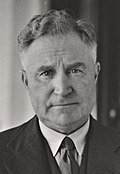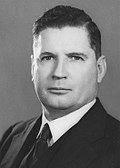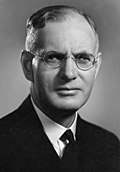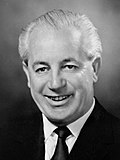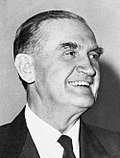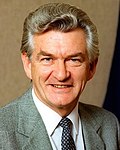The prime minister of Australia is the leader of the Australian Government and the Cabinet of Australia, with the support of the majority of the House of Representatives. [1] [2] Thirty-one people (thirty men and one woman) have served in the position since the office was created in 1901. [3] The role of prime minister is not mentioned in the Constitution of Australia, [4] but the prime minister is still appointed by the governor-general who under Section 64 of the constitution has the executive power to appoint ministers of state. The governor-general is appointed by the monarch of Australia based on the advice of the incumbent prime minister. [2] Governors-general do not have fixed terms, but usually serve for five years. [5]
Contents
- List of prime ministers
- Political parties
- Timeline
- Career-based timeline
- Key
- Notable moments
- Timeline 2
- See also
- Notes
- References
- External links
Federal elections must be held every three years, although prime ministers may call elections early. [6] Prime ministers do not have fixed terms, and generally serve the full length of their term unless they lose the majority of the House or are replaced as the leader of their party. Three former prime ministers lost a majority in the House (Alfred Deakin on two occasions, George Reid and Andrew Fisher), six resigned following leadership spills (John Gorton, Bob Hawke, Kevin Rudd, Julia Gillard, Tony Abbott and Malcolm Turnbull) and three died in office (Joseph Lyons, John Curtin and Harold Holt, who disappeared and is presumed to have died). [7]
Two prime ministers also lost their role in a double dissolution election, a snap election where the entire Senate stands for re-election rather than the typical half to resolve deadlocks between the two houses. These were Joseph Cook in 1914 and Malcolm Fraser in 1983. One prime minister, Gough Whitlam, was dismissed by the governor-general during a constitutional crisis. [8]
Since the office was established in 1901, thirty men and one woman have been prime minister. Robert Menzies and Kevin Rudd served two non-consecutive terms in office while Alfred Deakin and Andrew Fisher served three non-consecutive terms. [9] The prime ministership of Frank Forde, who was prime minister for seven days in 1945, was the shortest in Australian history. [10] Menzies served the longest, with eighteen years over two non-consecutive periods. [11] The current prime minister is Anthony Albanese, who assumed office on 23 May 2022. [9] There are currently seven living former prime ministers. The most recent former prime minister to die was Bob Hawke, on 16 May 2019. [12]















